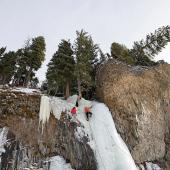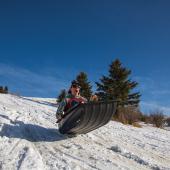Flying Wild
From hundreds of feet in the air, Bozeman is a latticework of tiny streets filled with miniature houses and toy cars. Minutes later, our tiny plane rises above a thick carpet of evergreens, streaked with ribbons of brown beetle-kill and patched with buzz-cut fields of logging. Civilization fades away and thousands of untouched acres spread out before us.
Bruce Gordon, president and chief pilot of EcoFlight, narrates the trip. His voice crackles through our bulky headsets, pointing out places we’ve been dozens of times to hike, fish, ski, and camp: Hyalite Reservoir, Lone Mountain, Electric Peak. From this height, it’s easy to see that a playground for us is actually a permanent home for wild populations of grizzlies, deer, and dozens of other species. He finds elk and bighorn sheep, just dots almost blending in with the hillside. He offers to open the window so we can get better photos of the surrounding mountains.
And the perspective isn’t the only unique aspect. In a commercial airplane, turbulence bumps up and down, left and right. Everyday directions. In this tiny six-seater, we twist and turn on every axis—imagine the plane hanging from a string, dangling free. Flying forward at over 100 miles per hour, we can feel the tail end swing toward the nose. The plane drops quick, and our hands float up to our chest and slap back down.
Gordon takes dozens of trips like this every year, showcasing the diversity of life and terrain in this complex and unique environment. This unique aerial perspective “gives the land a voice,” he says, making it simpler for people to see what’s at stake and how closely Bozeman and Yellowstone Park are connected. This 75-mile wildlife corridor is just a small but important piece of the Greater Yellowstone Ecosystem, connecting adjoining landscapes and giving the animals richer genetic diversity—as long as humans don’t clog it with highways, construction, and logging. EcoFlight supports the work of many conservation groups that work hard to protect these precious lands. With oil and gas companies constantly trying to increase their operations, explains Gordon, these groups are a critical counterbalance, providing valuable wildlife data and keeping rampant development in check.
After an hour in the air, we head back north toward town. Compared to the green forest stretching to the horizon in every direction, Bozeman looks small, insignificant. Gordon’s hope is that more people will realize how small we really are—and how important it is to stay that way.
Learn more at ecoflight.org.













